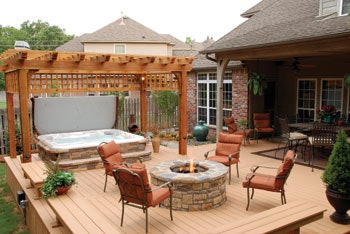
As homeowners demand more from their hot tub systems, manufacturers have responded with almost infinite combinations of jets, seating contours and other elements including lighting schemes and sound systems. For many homeowners, however, that level of luxury is just the beginning as they not only enjoy the soothing waters but also demand ways to visually integrate their vessels into backyard garden settings.
It's a combination that bodes well for the hot-water industry: On one side of the equation, as baby boomers age and health concerns become more immediate, the desire for the benefits of hydrotherapy increases the demand for hot tubs. On the other side, many homeowners are increasingly interested in creating home environments that offer vacation-like experiences they can enjoy every day.
Those factors and others spell opportunity for those selling portable hot tubs, especially for professionals who take a creative approach to integrating showroom units into developed settings in clients' homes. Doing so, say some portable spa professionals, provides customers with both the benefits of hot-water relaxation and therapy, in harmony with beautiful ambiance that further enhances the hydrotherapy experience, all the while generating increased pride of ownership.
With this confluence of trends comes the need for portable spa professionals to think creatively — more like swimming pool and inground spa designers or even landscape architects for whom arranging the aquatic elements requires an almost intimate level of collaboration with clients.
In The Pocket
These opportunities, as well as the challenges that come along for the ride, have impacted thinking for both manufacturers and dealers. According to Kacy Rivers, brand manager for Hot Spring Spas, "Aesthetics are very, very important. People are making big investments in their hot tubs, which often represent a permanent addition to their properties. From the shoppers' standpoint, they're often looking for something that works with their ideas about the appearance and ambiance of their backyards."
Coming to that realization, she adds, affords greater opportunities for dealers to connect with clients by way of in-depth conversations about aesthetic options, while also adding a layer of responsibility in meeting customers' demands: "From the sales standpoint, it's up to manufacturers and dealers to be sure that we show all of the aesthetic options, the shell, the cabinet material, anything that we can offer to add to the visual appeal of the hot tub.
"That's why we encourage our dealers to show every option that we have available, so that the customer has an opportunity to touch and feel it, because, ultimately, the decision to buy is both a practical and quite often an emotional decision."
With that in mind, progressive-thinking manufacturers have embraced the challenge with product offerings that boast vastly improved aesthetics. This means greater manufactured options in the form of synthetic and even natural wood and stone materials used in skirts and surrounds. "Spas certainly have evolved over time in terms of the appearance of the product," notes Rivers. "Yes, there has been the unfortunate perception that portable spas look like a box of water."
She's quick to add, however, "That has challenged manufacturers to develop ways that hot tubs fit in a designed setting. In our case, this led us to develop the Custom Cabinet option where virtually any type of material can be installed on the spa skirt. That way, materials once associated only with inground concrete spas are now available to consumers who want the wonderful benefits from manufactured hot tubs."
On The Ground
Improving aesthetic options is, of course, nothing new to those working in both inground pools and spas. Indeed, over the past 20 years or more, the backyard oasis has become a common fixture in the suburban landscape. According to some hot-water specialists on the dealer level, although the trend toward improved aesthetics is certainly welcome, the trend has also been due at least in part to challenging economic conditions.
"We've been integrating portable spas into designed settings for years," say Renee Gibbs, owner of Spas by Renee, a dealer located in Las Vegas. "Now in this current market with everything from personal income to home values becoming quite diminished compared to previous years, in-ground gunite spas are too expensive for many consumers."
Although unfortunate for potential customers looking for concrete spas, according to Gibbs, those current market conditions have pointed some of those same clients toward portable options. "With housing prices at such a low level, many people don't want to put hard equity into their backyards, but still want the benefits of hydrotherapy, so they turn to portable products," she says. "Many of those customers then start looking for ways to integrate the hot tub into their yards in an attractive way, to make the portable spa more aesthetically pleasing."
For Gibbs integrating hot tubs into the setting is an idea that once fell on mostly deaf ears: "Probably six to eight years ago, I started bringing this up to manufacturers with ideas about things that they could do to make it easier for those of us on the dealer level to achieve the inground look," she recalls. "At the time, I didn't feel that those conversations went very far because it was too difficult for the manufacturers based on the extensive guidelines they have to follow.
"For the most part, it's really been up to us on the dealer level to create the options for the customers."
In The Eyes
In essence, this trend has altered the role of the spa dealer, where once it was simply a matter of presenting products in an attractive way on a showroom floor, working with customers now means sometimes thinking and acting like a landscape designer or at the very least collaborating with design professionals.
"As a result," says Gibbs, "we've had to become much more creative improving the aesthetics of portable spas so they have something close to the inground look, while still retaining the benefits of the hydrotherapy designs as well as the energy efficiency."
That has meant at times working with landscape architects or designers, becoming involved in the process at an early juncture and being open to a variety of schemes where spa units are partially sunk in the ground or even flush with the grade, and are often strategically placed among traditional hardscape elements.
"Once you know what needs to happen in terms of preparation, then we work with the homeowner or their contractor to go through the step-by-step preparation," says Gibbs. "Obviously visually integrating a portable spa requires more effort and sophistication than simply delivering it, hooking up the electrical service and filling it. Most clients seeking the integrated look understand that already."
"One of the big differences is that prospective clients begin thinking more actively about what they want in their backyard well ahead of time," agrees Rivers, "much the way you would with a swimming pool or an in-ground spa, but now they can factor in all of the hydrotherapy benefits that come with portable hot tubs."
Entry & Egress
Portable hot tubs are all about human interaction, which is why getting into and out of the water is one of the most important issues driving consumer satisfaction.
"We want to be sure that our customers use their hot tubs as much possible," says Kacy Rivers, brand manager for Hot Spring Spas. "Ultimately the benefits come from how often they use it. We want that investment to mean as much as possible. After all, oftentimes you have people choosing to buy a hot tub in favor of a vacation, which only lasts a matter of days or maybe weeks. We want the customer experience to be a regular part of their lives. And that means they have to be comfortable moving in and out of the water."
In addition to that, she continues, steps and decks can also be used in clever ways to visually integrate the units into their settings. "That's why we offer steps that are made of the same type of material that the surrounds are made of. In our case that's synthetic wood or stone material that complements the hot tub. Also, lowering the hot tub part way or all the way recessed into the ground is a wonderful way to ease access."
For all the importance of aesthetic schemes, there's also a need to ease the use of spa covers. "All hot tubs should be equipped with a cover for the purposes of safety, energy efficiency and keeping the water clean. Yet, if you don't have a cover lifter," says Rivers, "moving the cover on and off the hot tub can become an obstacle to use." Cover removal can present a real challenge for people who don't have the physical strength, or are injured or disabled somehow. And often it's those people who would have the most difficulty moving the cover that are using the hot water for therapeutic reasons.
Comments or thoughts on this article? Please e-mail [email protected].








































